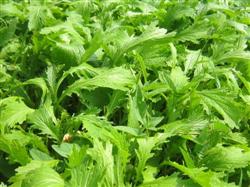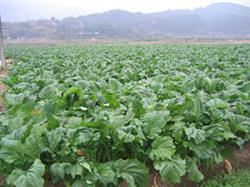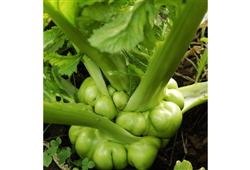How can leaf mustard be planted with high yield?

How can leaf mustard be planted with high yield? Please guide that leaf mustard is one of the most abundant and diverse varieties of mustard. Except for a few fresh vegetables, most of them are stained vegetables. In recent years, with the adjustment of industrial structure in rural areas, the area of planting and processing leaf mustard has gradually increased, but in order to do a good job in the production of leaf mustard and improve the yield and commodity quality, we must grasp the following key links. 1. Choose the sowing date. Leaf mustard requires a cool and warm climate, and the suitable temperature for growth is 15 ℃ 20 min. Large-scale or heart-wrapped varieties requiring cool and strict requirements are mainly sowed in autumn, that is, sowing in early September and harvesting around December; varieties with strong adaptability to high temperature can be sowed in early autumn, that is, sowing in August and harvested around November; varieties with late bolting can be sowed in late autumn, that is, sowing in lo month and harvested around March of the following year; varieties susceptible to virus disease can be sowed late, and varieties that are not susceptible to virus can be sowed early. Varieties that are not easy to bolting, have strong adaptability to high temperature and can be eaten with smaller plants can be sown from February to September and harvested after 30 minutes. Early sowing can be made in cool areas or mountainous areas, and sowing time can be postponed in warm areas or as late rice. Early-maturing varieties can be sowed early, while late-maturing varieties can be sowed late. 2. Cultivate strong seedlings. Most of them are planted after raising seedlings, and the varieties fed by smaller plants can also be direct seeded. Early autumn sowing should choose good soil for water conservation and fertilizer conservation as seedbed, late autumn sowing should do a good job of drainage, seedling bed ploughing, full exposure, adequate organic fertilizer, fine soil preparation, sowing 50 grams for every 67 square meters of seedbed, can plant 1333 square meters in the field. Cover soil 1ml 2cm after sowing, sow in early autumn should also be covered with grass to moisturize, remove in time after budding, pay attention to watering in the morning and evening before emergence, 2 Rue 3 true leaf time seedlings, seedling spacing 3-6 cm, and apply rotten thin human feces. Pay attention to the prevention and control of aphids at seedling stage. 3. Timely planting. It is better to keep water and fertilizer and moisten the loam soil, and the width of the border is 1.2 meters 1.4 meters. Manure or stable manure was applied before soil preparation, the seedling height was 12 ~ 15 cm, and it was planted with 5 ~ 6 true leaves. The seedling age was about 25 days in early sowing, 30 days in autumn and 40 days in late autumn. The plant spacing of precocious seed line and plant is 33ml 40cm × 330cm, and that of middle and late mature variety 40Mel 45cm × 33Mel 30cm. Prevent root injury, root group distortion and hanging in the air during planting. 4. Field management. 2Mel was watered for 3 days after planting. Those sowing in early autumn should prevent drought in autumn. Those sowing in late autumn should do a good job in drainage. Nitrogen fertilizer is the main fertilizer, and proper application of phosphorus and potassium fertilizer in seedling stage and field can improve disease resistance. After the colonization survived, human and animal feces and urine were applied for 5 times, from light to thick. Early autumn sowing should be timely topdressing, late autumn sowing before spring do not fertilize, otherwise the growth is tender, in colder areas, vulnerable to freezing damage. After the beginning of spring, it grows very fast, and it is necessary to apply more nitrogen fertilizer to promote leaf growth and improve quality, such as insufficient nitrogen fertilizer, dry soil and weak plants, so bolting early should be managed early after overwintering, watering and fertilization should be made in time to make vegetative growth flourish. it is an effective measure to improve yield and quality. Processing mustard stop topdressing in the first half of the harvest, watering and topdressing combined with ploughing and weeding. Mustard moss and flowering does not have to go through low temperature, but requires a certain amount of long sunshine. Autumn mustard generally does not bolt in short days, while spring sowing mustard is very easy to bolt. Through vernalization, there are types with high requirements for low temperature, and some are not strict with low temperature. Although some varieties pass vernalization, flower buds develop due to low temperature. Slow growth, even if bolting, can not blossom. However, in the bolting period, the harvest does not affect the processing quality, but increases the yield. At the same time, mustard flower moss is generally stout, soft and succulent before flowering, and it is also an excellent material for processing. The disease was mainly virus disease. Aphids were thoroughly controlled in seedling stage and early growth stage after planting. 7-lo was sprayed with 40% dimethoate 1000 times liquid once. The yellow striped beetle larvae harmed the roots, and the ammonia water was 20 kg / mu. 5. Harvest in time. Early autumn sowing is generally harvested around December; early maturing varieties of autumn sowing and late autumn sowing are harvested in March; late maturing varieties are harvested in April, or they can be harvested by peeling leaves when 5 Mel leaves are 6 leaves. After leaf stripping, combined with topdressing, the seedlings were harvested at any time 40 days after planting. The yield per mu of early autumn sowing is 1500kg / mu, autumn sowing is 2000kg / mu, and late autumn sowing is more than 3500 kg. Sowing in spring and summer is about 1000 kilograms. Click to get more mustard planting techniques click to get more vegetable planting techniques
- Prev

What are the ways to grow mustard?
How to cultivate mustard for organic stem? Please introduce the method of organic stem cultivation with mustard can refer to the following methods: 1. Sow seeds and raise seedlings. ① seedbed selection. Choose the soil that is deep, loose, rich in organic matter, sunny terrain and convenient for drainage and irrigation. Avoid planting cruciferous vegetable fields such as cabbage, lotus white, pediatrics, etc.
- Next

How to grow mustard for stem?
How to grow mustard for stem? Please introduce the methods of planting and management of stem mustard, alias green vegetable head, cabbage, croaker, water chestnut, etc., which is a variety of Brassica cruciferae. It can be boiled, soaked, cooled, fried and pickled. The variety with protuberance on the inflated stem is suitable for processing.
Related
- Where is it suitable to grow horseradish in China? it is expected to see the middle altitude horseradish in Alishan.
- How to prevent tomato virus disease reasonably? (Control methods included)
- Many people like to plant towel gourd on the balcony. What are the main points of this method and management?
- What crops can chili peppers be mixed with?
- Fertilization techniques and matters needing attention in Tomato
- What are the grafting techniques for peach seedlings in spring?
- Harm and control methods of root swelling disease of Chinese cabbage
- What are the pests of sweet potatoes? How to prevent and cure it?
- Symptoms, causes and Control methods of navel Rot in Tomato
- The cause of "Cucumber rotten bibcock" in Farmers' planting Cucumber and its Control Plan

